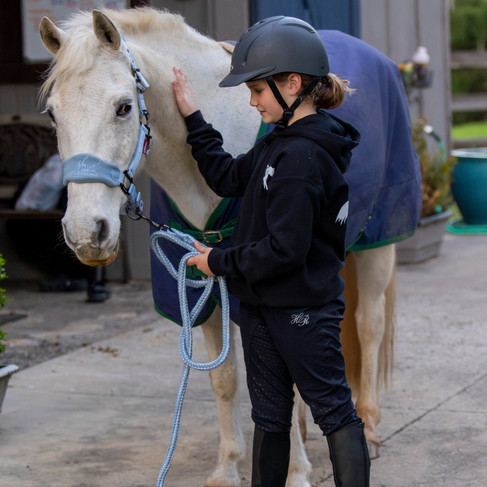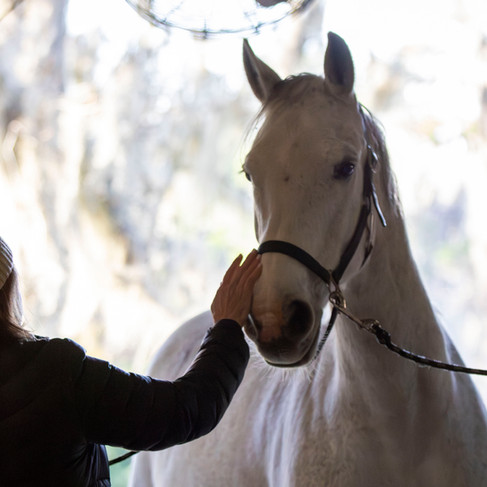Show Me the LOVE | Learning the Dos and Don'ts of Positive Reinforcement at Eden Farm
- Megan Galloway
- Jan 21, 2024
- 4 min read
Updated: Aug 21

Working with horses has been used over multiple decades to establish a variety of social understandings in humans. From trauma recovery to developing confidence in young people, the skills learned when communicating with horses are endless. One such skill that we strive to implement for our young riders at Eden Farm is the utilization of Positive Reinforcement.
Positive reinforcement may seem like a basic idea, but applying it to horse communication is actually a learned skill. First, let’s talk about the definition of positive reinforcement. It is about as simple as the name implies and involves using some form of reward to encourage desired behavior. Positive reinforcement is also often referred to as +R with the + sign equalling positive and the R standing for reinforcement.
There are several elements to the strategy of positive reinforcement including -
Positive reinforcement - adding something to encourage behavior (giving the horse a pat or treat for going forward on the leadline)
Positive punishment - adding something to discourage a behavior (putting pressure on the horse’s leadline to go forward)
Negative reinforcement - taking something away to encourage a behavior (releasing pressure on the horse’s leadline when he moves forward willingly)
Negative punishment - taking away something to discourage a behavior (removing a treat until the horse moves forward willingly)
Now that you get the basics, you’re probably wondering how this method applies to young riders. To make a well-rounded rider, horsemanship needs to start from the ground up and positive reinforcement is a wonderful tool to teach both horses and handlers a way to build a strong and safe bond. Not only will practicing positive reinforcement give the new rider tools to confidently handle their mount, but it will also give horse and human time to get to know each other!
Starting to train on the ground, riders should focus on the small aspects of each individual task. Does the horse or pony stand nicely or walk over willingly in the stall?
Does he or she stand nicely on the cross ties and walk well beside the handler?
As the handler practices positive reinforcement on these basic tasks, they will begin to feel more and more confident in their ability to properly ask the horse what to do to get a correct response. Spending this time working with the horse will also get the handler familiar with any personality traits or quirks that horse has so that they are better in tune with the animal they are working with.
Here are a few of our favorite positive reinforcement examples to practice at Eden Farm ~
We take time at the barn and in our camps to teach our students how horses need to respect them and stay out of their “bubble” of a 3’ to 6’ space around them.
We practice leading and stopping, making sure the horse is keeping eyes on their handler and responding to our cues. If the horse does what we ask, we give them a pat on the neck and send them love. The horses feel your energy, emotions and spirit. I tell the students to be tough, but fair. If your horse goes past you on the lead rope and drags you forward, it is time to be tough with a hard shake and some backing up out of the bubble. If your horse is obediently following and stopping and making eye contact, it's time to reward them with a smile and a hard rub.
Horses prefer a stronger touch. To reach out to them with fingertips feels like a bug landing on them. To scratch their withers, or chest, or rump feels like another horse - which they like. We also teach all of our students these little details.
Another example is to have good technique over the jumps. If a rider doesn’t hold themselves tightly to the saddle, but “let’s go” with their reins or their body they lose their horse’s trust, and the next jump they may run out or stop. Technically, this is negative punishment to the horse you are jumping.
Making a promise to the horses we ride to have good technique and stay quiet, strong, and tight in the saddle as we jump is positive reinforcement. When we do this they partner with us better and as we say in our lessons, all the jumps become smooth and fun.
The goal of bonding with your horse, and of practicing positive reinforcement, is to be able to better communicate across the ‘quite obvious’ language barrier. By engaging in consistent practices with the horse, you will be able to create a language that you both understand! Being able to communicate and understand each other leads to both happy horses and happy riders. As flight animals, horses are incredibly sensitive to the energy and emotions around them – meaning if you are upset, they will know.
A consistent communication style leaves less room for confusion which means a greater chance of success in each ride.
Whether you are looking to enroll your child in a Beginner Lesson Program or continue your own education within the hunter/jumper discipline, reach out to Megan at 352- 572-7658 and see if you are a good fit for any of our lesson programs at Eden Farm in Ocala, Florida.












Comments